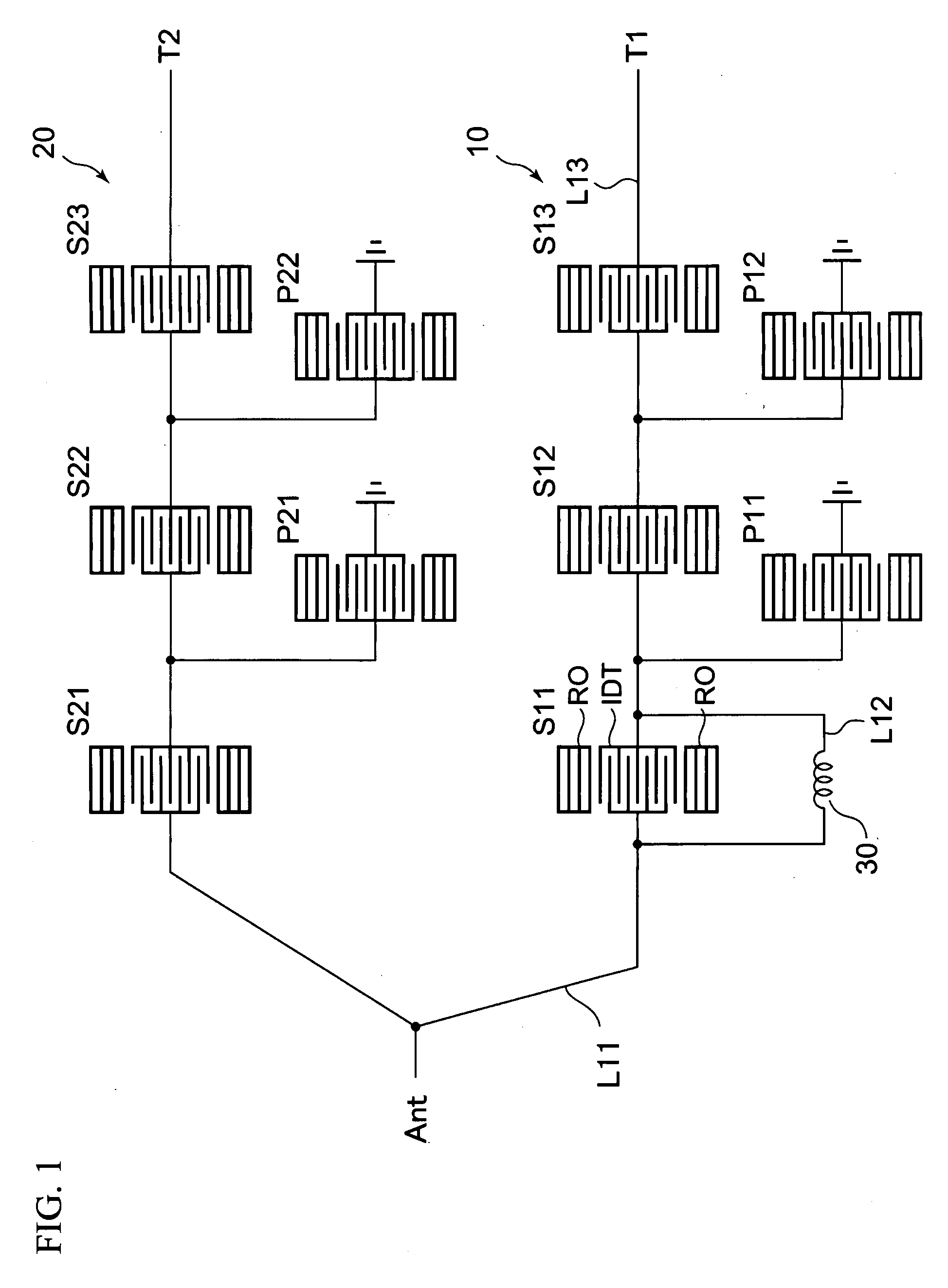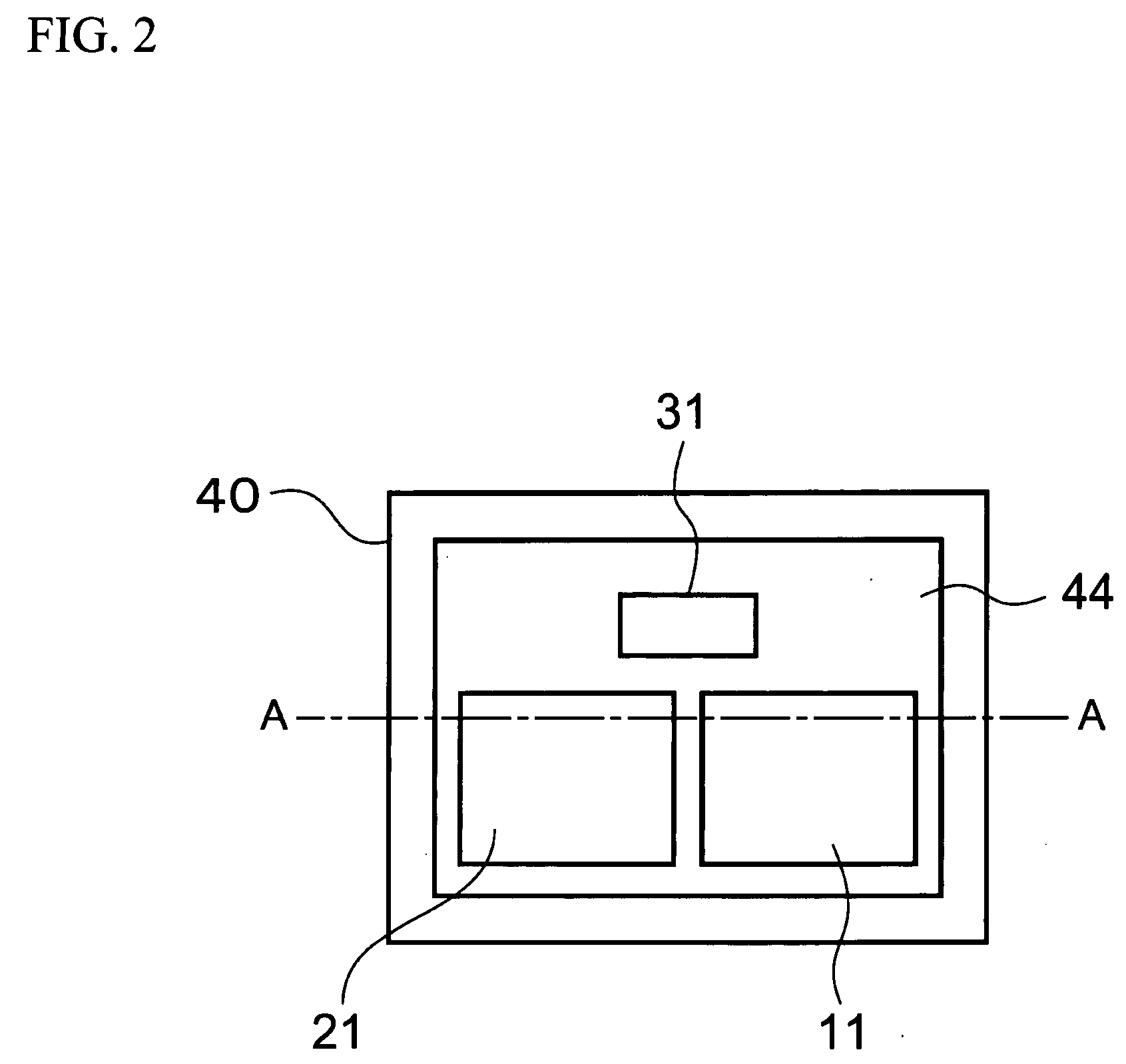Filter and duplexer
a duplexer and filter technology, applied in the direction of impedence networks, electrical apparatus, piezoelectric/electrostrictive/magnetostrictive devices, etc., can solve the problems of difficult to produce small-sized or thin devices, difficult to produce small-sized or thin portable terminals, etc., to reduce mutual inductance, reduce the effect of mutual inductance and high suppression
- Summary
- Abstract
- Description
- Claims
- Application Information
AI Technical Summary
Benefits of technology
Problems solved by technology
Method used
Image
Examples
first embodiment
[0045]A first embodiment of the present invention is an example where a duplexer for 2-GHz band W-CDMA systems having ladder filters is mounted on a stacked package. In this embodiment, a first filter 10 having a first inductor 30 connected in parallel to series-arm resonators serves as a reception filter, and a second filter 20 serves as a transmission filter. FIG. 1 is a circuit diagram of a duplexer in accordance with the first embodiment. As shown in FIG. 1, the first filter 10 (a reception filter) is connected between a common terminal Ant (an antenna terminal) and a first terminal T1 (a reception terminal). The second filter 20 (a transmission filter) is connected between the common terminal Ant and a second terminal T2 (a transmission terminal). The first filter 10 is a ladder filter, and includes series-arm resonators S11 through S13 and parallel-arm resonators P11 and P12. The second filter 20 is also a ladder filter, and includes series-arm resonators S21 through S23, and ...
second embodiment
[0060]A second embodiment is an example where the directions of the currents flowing through the common line L11 and the first terminal line L13 are also at 90 degrees with respect to each other, as well as the directions of the currents flowing through the first inductor line L12 and the first terminal line L13. FIG. 10A is a plan view showing the surface of the die-attach layer 44 of Comparative Example 1, and is the same drawings a FIG. 7A. FIG. 10B is a plan view of the surface of the die-attach layer 44 of a duplexer in accordance with the second embodiment. The other stacked layers are the same as those of the first embodiment, and explanation of them is omitted here. The die-attach layer 44 of this embodiment differs from the die-attach layer 44 of the first embodiment shown in FIG. 7B in that the directions of the currents flowing through the common line L11 and the first terminal line L13 are substantially at 90 degrees with respect to each other, as well as the directions ...
third embodiment
[0063]As shown in FIG. 12, a third embodiment of the present invention is an example case where a first filter 10a having a first inductor 30a connected in parallel to a series-arm resonator is used as a transmission filter, and a second filter 20a is used as a reception filter. A first terminal T1 serves as a transmission terminal, and a second terminal T2 serves as a reception terminal. The series-arm resonators S11 through S13 and the parallel-arm resonators P11 and P12 of the first filter 10a (the transmission filter) are formed in a first filter chip 11a. The series-arm resonators S21 through S23 and the parallel-arm resonators P21 and P22 of the second filter 20a (the reception filter) are formed in a second filter chip 21a. The first inductor 30a is formed in an inductor chip 31a. A common line L11 connects a common terminal Ant and the first filter 10a. A first inductor line L12 connects the first inductor 30a and the series-arm resonator S11. A first terminal line T13 conne...
PUM
 Login to View More
Login to View More Abstract
Description
Claims
Application Information
 Login to View More
Login to View More - R&D
- Intellectual Property
- Life Sciences
- Materials
- Tech Scout
- Unparalleled Data Quality
- Higher Quality Content
- 60% Fewer Hallucinations
Browse by: Latest US Patents, China's latest patents, Technical Efficacy Thesaurus, Application Domain, Technology Topic, Popular Technical Reports.
© 2025 PatSnap. All rights reserved.Legal|Privacy policy|Modern Slavery Act Transparency Statement|Sitemap|About US| Contact US: help@patsnap.com



